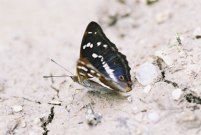 |
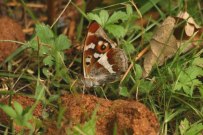 |
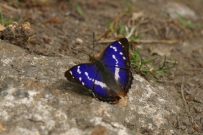 |
© photo: Glen Barnes |
© photo: Nick Sampford |
© photo: Nick Sampford |
| Essential reading! Hertfordshire Purple Emperor Reports can now be downloaded free. | |
The Purple Emperor is the only butterfly identified in the Thames Regional Action Plan as having High Priority status in Hertfordshire or Middlesex. It is also Hertfordshire BAP Species.
The bright green egg is laid on the upper surface of a sallow/willow leaf (salix sp.) and usually hatches within 16 days.
The tiny caterpillar feeds on sallow/willow leaves into the autumn, usually early November. Winter is spent pressed against a dormant bud or in the fork of a twig on a silk pad. After hibernation, they continue to feed on the sallow/willow leaves. The caterpillar has four skin changes: two before and two after hibernation. After their final moult the caterpillar is 35-40mm long
The pupa is formed during June and hangs from the underside of a leaf. This is the most difficult stage to observe and the exact time of pupation is not known although believed to be between 2 and 3 weeks.
Flight time can be within the period from the 4th week of June to the middle of August at the extremes, but the peak period when most activity in Hertfordshire has been observed is during the middle of July. Their flight is very distinctive as they are large and are one of the few British butterflies to glide. Both the male and female appear dark in flight, although the female is slightly larger. The upperwings of the male can refract a purple sheen when seen at a some angles
Only the White Admiral is in any way similar and this is smaller
and is more likely to be seen low down and
feeding on nectar, although it may appear brown
in certain lights, it is also a distinctly
rounded butterfly.
A picture guide to help
identify 'high flying' summer woodland butterflies
The Purple Emperor may be seen gliding
between gaps in the tree canopy although,
occasionally, one will be seen taking salts from
the ground or 'waste matter.' The
highlight is to see males clashing around the
'master tree.' For breeding, the female
uses Salix leaves that are on the shady side or
within the crown of the tree. The female usually
lays her eggs during the middle of the day.
Where to Look
It is well worth patiently exploring Salix-rich
woodland from the end of June, particularly
concentrating on tall oaks that stand above the
rest of the canopy on high ground or hillocks.
Sallows with their characteristic catkins (pussy
willow) are highly visible in the spring. Sallows
flower before the surrounding leaves have emerged
- this is the best time to determine whether a
wood is Salix-rich.
Help with monitoring?
There over 15 sites in Hertfordshire and Middlesex where Purple Emperor have been seen since 1999. It is becoming an
almost impossible task to monitor them all effectively especially on the peak days
of territorial activity. We are always looking to recruit volunteers who will
be able to go at short notice to specific sites, on specific days and just watch territories for us. We want
to be able to monitor all sites at the same time, so we can gain a greater understanding of populations levels at all sites on the same days. This will also enable us to visit some of the private sites
and look for new territories on peak days. The essential requirement will be patience. If you think you can help please contact Liz Goodyear or Andrew Middleton for more details.
Training will be given.
Sites
If
a new site is found it is essential that the
owner is informed before the news is made public. Andrew Middleton and Liz
Goodyear will be happy to help advise in their
capacity as Species Co-ordinators. It is
important that landowners, and woodland managers
understand the importance of this species and
guidance must be given for future management.
The following reports by Liz Goodyear and Andrew Middleton are now available to download free.
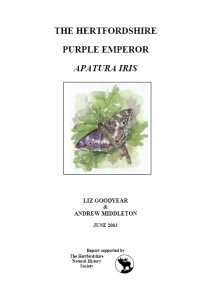 |
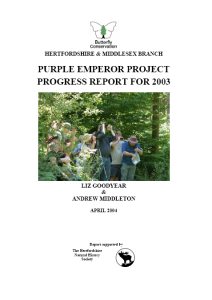 |
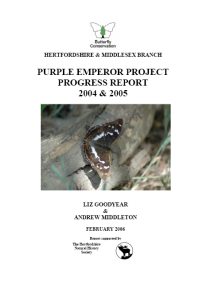 |
| The Hertfordshire Purple Emperor 2002 |
The Hertfordshire Purple Emperor Project Progress report for 2003 |
The Hertfordshire Purple Emperor Project Progress report for 2004 & 2005 |
| Downloads ~ Adobe Acrobat format (PDF) :- | |
Supported by the Hertfordshire Natural History Society
This is the first
report and covers the early years of study of the Purple Emperor and
its favoured haunts.
The report covers the following aspects of the study:
Purple Emperor Project Progress Report for 2003 ~ published April 2004
Supported by
the Hertfordshire Natural History Society
This is the second report and covers the continued study of the Purple Emperor in 2003
Purple Emperor Project Progress Report 2004 and 2005 ~ published February 2006
Supported by
the Hertfordshire Natural History Society
This is the third report and discusses the continued study of the Purple Emperor during 2004 and 2005 in Hertfordshire
Text by Liz Goodyear and Andrew Middleton
March 2010 (updated February 2015)
Please send any records of colonies, singletons or potential sites to:
Liz Goodyear
Telephone: 01920 487066
Email: elizabethgoodyear.t21@btinternet.com